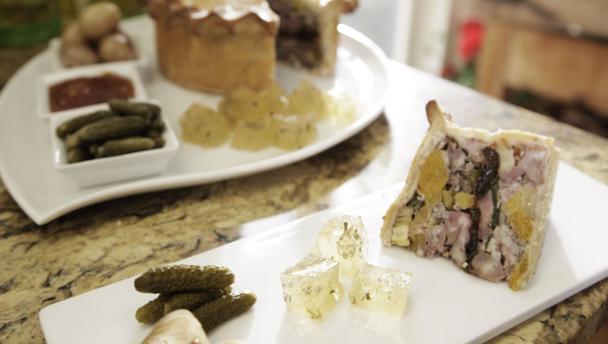Quick recipe finder Pork, leek and apricot raised pie with cider and sage jelly 
Make your own pork pie with a delicious twist – the jelly is infused with cider and sage and served alongside.
 By The Hairy Bikers From Hairy Bikers Everyday Gourmets
By The Hairy Bikers From Hairy Bikers Everyday Gourmets
Ingredients
For the cider and sage jelly
- 6 sheets leaf gelatine
- 75g/3oz caster sugar
- 100ml/3½fl oz cold water
- 300ml/10fl oz dry cider (this needs to be fizzy)
- 1 tbsp finely chopped sage leaves
For the filling
- 400g/14oz pork shoulder, fat trimmed, cut into 1.5cm/½in chunks
- 150g/5oz pork belly mince
- 100g/3½oz bacon (pork collar), cut into 1.5cm/½in chunks
- 100g/3½oz ready-to-eat apricots, cut in half
- 1 leek, trimmed, cut into 1cm/¼in slices
- ½ tsp ground ginger
- ½ tsp ground allspice
- ½ tsp finely grated nutmeg
- 1 medium free-range egg, beaten
- 1 tsp sea salt flakes
- freshly ground black pepper
- 8 ready-to-eat prunes
For the pastry
- 425g/15oz plain flour, plus extra for dusting
- ½ tsp freshly ground black pepper
- 50g/2oz chilled butter, cut into cubes, plus extra, softened, for greasing
- 150g/5oz chilled lard, cut into cubes
- 150ml/5fl oz water
- 2 tsp sea salt flakes
- 1 free-range egg, beaten, for glazing
Method
For the cider and sage jelly, line a 15cm x 25cm x 5cm/6in x 10in x 2in roasting tray or ovenproof dish with cling film.
Soften the gelatine leaves by placing them in a bowl and covering with cold water. Set aside for five minutes, or until pliant.
Heat the sugar and water in a lipped saucepan, stirring until the sugar has dissolved. Bring the mixture to the boil for 30 seconds, then remove the pan from the heat and set aside for five minutes.
Squeeze any excess water from the gelatine leaves and add to the pan of warm sugar syrup. Stir with a wooden spoon until dissolved.
Slowly pour the cider into the pan, at one side. Mix gently. Pour the mixture into a jug and chill in the fridge for 1½-2 hours, or until the jelly has started to set. (You need it to hold the sage in suspension, so don’t let it set too much or too little.)
Once chilled, remove the jelly from the fridge and, using a fork, whisk the chopped sage into it. This will create bubbles and make the jelly look fizzy. Pour the haf-set jelly into the lined roasting tray or dish, cover with cling film and return to the fridge for at least three hours, or until fully set.
Meanwhile, for the filling, mix the pork shoulder, pork belly mince, bacon, apricots, leek, ground ginger, allspice, grated nutmeg, egg and salt in a large bowl until well combined. Season with freshly ground black pepper and mix again.
For the pastry, grease the inside of a 17.5cm/7in spring-form cake tin with butter.
Sift the flour into a large mixing bowl and stir in the pepper. Using your fingertips, rub the butter and 50g/2oz of the larb into the flour until the mixture resembles fine breadcrumbs. Make a well in the centre of the mixture.
Heat the remaining lard and the water and salt in a small saucepan over a medium heat. When the mixture is simmering, pour it into the well in the flour and stir with a wooden spoon, gradually drawing the dry mixture into the liquid until the mixture comes together as a dough.
Tip the dough out onto a lightly floured work surface and knead until smooth and pliable. Cover with cling film and set aside to rest for 30 minutes. (Do not put the dough in the fridge; it will become hard and crumbly.)
Once the pastry has rested, unwrap it and cut off one-third to be used as the pie lid. Roll the remaining two-thirds of pastry into a ball and roll out onto a lightly floured surface to a thickness of 7mm.
Line the prepared spring-form tin with the pastry, pressing into the base and sides of the tin to prevent air bubbles from forming. Leave the excess pastry hanging over the edge of the tin.
Spoon half of the filling mixture into the pastry case, pressing it down firmly with the back of a spoon. Flatten the prunes with the palms of your hands and arrange them on top of the filling mixture. Cover the prunes with the remaining filling mixture, pressing down as before.
Roll out the reserved one-third of pastry until it is large enough to cover the pie. Brush the overhanging edges of the pie with water and place the pastry lid on top, squeezing it together at the edges to seal. Trim off most of the excess pastry using scissors, crimping the decorative edge. (You can use the trimmings to decorate the pie lid if desired.) Make a small hole in the centre of the pie lid using a sharp knife. Chill in the fridge for 30 minutes.
When the pie is ready to cook, preheat the oven to 180C/350F/Gas 4. Place the pie tin onto a baking tray and bake in the centre of the oven for 1¼ hours. Remove from the oven and very carefully release the sides of the spring-form tin. Leave the pie on the tin base and return to the baking tray.
Inspect the pie for cracks, patching any up with the pastry trimmings, smoothing into place with beaten egg. Then brush the pie all over with a little beaten egg to glaze. Return to the oven for a further 15 minutes.
Remove the pie from the oven and glaze again with more beaten egg. (If the juices are beginning to run out of the top of the pie, make a small chimney out of a piece of aluminium foil and stick it into the hole in the pie lid.) Return the pie to the oven for a further 10-15 minutes, or until the pastry is golden-brown. Set aside to cool for at least six hours before serving (chill in the fridge once cooled).
To serve, remove the cling film from the jelly and turn it out onto a chopping board. Cut the jelly into 2cm/¾in cubes. Cut the pork pie into wedges and serve with a few cubes of cider and sage jelly alongside.
Recipe Tips
To release the pie from the spring-form tin without breaking it, place the base of the tin onto an upturned bowl, release the clip, loosen any sticky edges with a knife if necessary, then allow the sides of the tin to drop away.
Related Recipes
Pork souvlaki with oregano
Small pork pies with quails’ eggs
This recipe is from…


